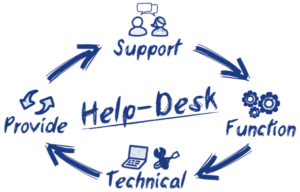Getting your email hacked can be alarming; the most popular way people realize that their email has been hacked is when a friend or family member lets them know that they received a strange email from them.
Email hackers target the public to take money from them fraudulently. One popular way they take people’s money is by getting unauthorized access to your email account and sending an email to your contacts. The email would be something suspicious, like that you are on vacation overseas and suddenly need help and money – could they please send money right away to the mentioned account. In other words, your email is “phishing” for money and information.
Unaware that it wasn’t really you who sent the email, and because it seems like a legitimate email from you, some contacts do send money to the fraudsters. Scary, right? It doesn’t have to be! If you’re proactive and call us at Rush Tech Support, we can make sure you and your contacts are protected.
If you ever recognize that your personal email has been hacked, do take these six actions right away:
1. Change your email password right away
Log into your email provider’s web mail portal and go to your account settings. This will help you secure identity theft protection. Typically, there is a Security section where you have the option to change your password. Choose a new, strong password that does not resemble the previous one. Email password hackers can determine your email very easily, so the more complex, the stronger the password is from being hacked. Think capital letters, numbers, symbols, underscores – sometimes an easy method is writing out words with numbers. It’s gr3@t!
- If you no longer have access to the account, use the ‘Forgot Password’ option to create a new one and recover access to your account.
- If you used this password in other sites/accounts, change those passwords as well and don’t use the same password in multiple sites.
2. Review your Account Settings
Review your settings, including your login history, contacts, linked Mail accounts, Signatures, Mail Forwarding, Banned Addresses, and Filters; delete anything that you don’t recognize. Delete any and all cookies from your history toolbar and your queue.
3. Scan for Viruses, Malware, and Spyware
There is a possibility that your computer/laptop may have contracted a virus, malware, and/or spyware when it was hacked. Running a virus scan to track any viruses is highly recommended. Also, running a Malwarebytes scan has shown great results spotting and removing these dangerous infections.
4. Alert your contacts
Use another source of communication to let your contacts know that your email has been hacked (text message, phone, a different email address) and request that if they recently received an email from you, they delete it without opening it, clicking on any links or downloading attachments. If you are sending an email, the Email Subject should be a warning that grabs the reader’s attention. Knowledge is power! If someone has opened a phishing email, have them call us at Rush Tech Support and we can run scans for the user right away.
5. Report the phishing attack to your provider
Different providers have different methods for reporting these incidents; search their website for their instructions.
6. Continue to monitor your email, financials, and other sensitive information
Unfortunately, your email history may have personal information that hackers now have access to- which is a hacker’s paradise.. Continue to regularly monitor the activity on your credit cards, including your transactions and other sensitive areas, to ensure no one else is accessing them.
How did this happen to me?
There are multiple ways it could have happened. One possible way is that your email was hacked while you accessed your email using a public Wi-Fi. A common approach that hackers use is called Evil Twin, and it works like this: Say you are at your favorite local coffee shop named “Strong Joe”, and you want to take advantage of their free Wi-Fi. What hackers will do is set up a second hotspot in that location, naming it similar to the authentic hotspot for that business. For example: The authentic hotspot for the business may be “Strong Joe,” while the hacker’s hotspot may be “Strong Joe FASTEST.” Sometimes business patrons will not notice that there are more than two hotspots with the name, and inadvertently use the hotspot that is set up by the hackers. While using the hotspot trap that hackers created, you may decide to log into your email and catch up with work, friends or family. When you do this, the hacker’s hotspot can grab the email’s security packets, which contain your credentials. And there you have it. You’ve been hacked without realizing it.
Should I stop using public hotspots?
Not necessarily – just be careful when logging into free, Wi-Fi hotspots. Ask an employee for the correct Service Set Identifier (SSID) and password so that you are not inadvertently using one that a hacker has set up, and use public hot spots only for web browsing – not for online shopping, banking or accessing anything that requires entering your user name and password.
As always, if you have any doubts, or wish to make sure you have followed all these steps above correctly; please be sure to contact us at(844) 881-7874 or +18448817874




